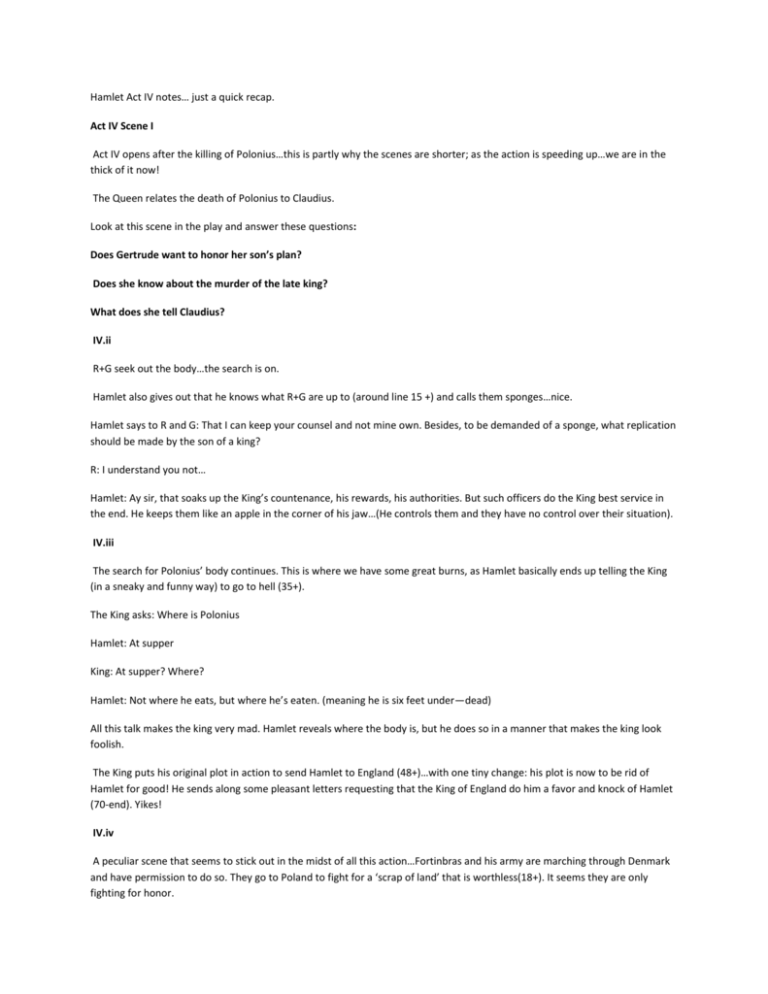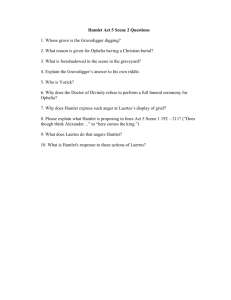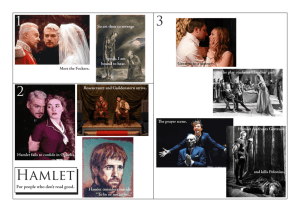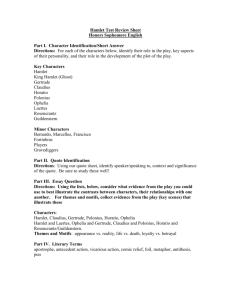Hamlet Act IV notes… just a quick recap. Act IV Scene I Act IV opens
advertisement

Hamlet Act IV notes… just a quick recap. Act IV Scene I Act IV opens after the killing of Polonius…this is partly why the scenes are shorter; as the action is speeding up…we are in the thick of it now! The Queen relates the death of Polonius to Claudius. Look at this scene in the play and answer these questions: Does Gertrude want to honor her son’s plan? Does she know about the murder of the late king? What does she tell Claudius? IV.ii R+G seek out the body…the search is on. Hamlet also gives out that he knows what R+G are up to (around line 15 +) and calls them sponges…nice. Hamlet says to R and G: That I can keep your counsel and not mine own. Besides, to be demanded of a sponge, what replication should be made by the son of a king? R: I understand you not… Hamlet: Ay sir, that soaks up the King’s countenance, his rewards, his authorities. But such officers do the King best service in the end. He keeps them like an apple in the corner of his jaw…(He controls them and they have no control over their situation). IV.iii The search for Polonius’ body continues. This is where we have some great burns, as Hamlet basically ends up telling the King (in a sneaky and funny way) to go to hell (35+). The King asks: Where is Polonius Hamlet: At supper King: At supper? Where? Hamlet: Not where he eats, but where he’s eaten. (meaning he is six feet under—dead) All this talk makes the king very mad. Hamlet reveals where the body is, but he does so in a manner that makes the king look foolish. The King puts his original plot in action to send Hamlet to England (48+)…with one tiny change: his plot is now to be rid of Hamlet for good! He sends along some pleasant letters requesting that the King of England do him a favor and knock of Hamlet (70-end). Yikes! IV.iv A peculiar scene that seems to stick out in the midst of all this action…Fortinbras and his army are marching through Denmark and have permission to do so. They go to Poland to fight for a ‘scrap of land’ that is worthless(18+). It seems they are only fighting for honor. Theme: ACTION Please read Act IV, scene iv, starting at line 33—Hamlet’s long soliloquy starting with “I’ll be with you straight”… Write a one paragraph response to his speech. What does it mean? The effect on Hamlet is that he sees Fortinbras and his men as being heroic (48+), as they are willing to give up their lives so freely for honor. This is a huge contrast to his own hesitation to act on his feelings and the growing evidence against Claudius. Now, Hamlet is out for revenge, or nothing: “O, from this time forth/ My thoughts be bloody or be nothing worth!” (IV.iv.67-68). IV.v This scene opens with a discussion about Ophelia’s madness… The King claims that her father’s death is what has caused it (75ish) Laertes, in secret, has come from France (87) = trouble, and he isn’t happy! In a bold move he overcomes the guards (103-104) The common people seem to be on Laertes’ side – they call him ‘Lord’ (105) and are calling for him to be crowned king (106109). This is a drastic move, as it would be considered treasonous to speak so against the current king. Revolution seems to be in the air, which usually includes bloodshed. What theme does the above best represent? Laertes and his supporters go so far as to break in the doors to gain entrance to where the king is…this is truly a violent and dangerous move. The king is in terrible danger of losing his crown (and perhaps his head!) (111-113), but Laertes dismisses his followers in order to deal with things on his own (113-117) Claudius, in a brilliant move, begins to recruit Laertes to help achieve his own ends… and claims he is innocent of killing Polonius (157+) How is the king acting in a manipulative fashion? Read this section of the play and determine the king’s motives. Ophelia enters, which doubles Laertes’ suffering, as he discovers she is insane (165+) Ophelia starts handing everyone dead flowers. She goes on about her father’s death and the ways of man. Read this section and infer as to whether you think she’s crazy or not. IV.vi The King, continuing his fancy footwork, gives two reasons for not acting against Hamlet (10+). These being, the Queen loves her son too much and couldn’t live without him (12+), and that the common people are on Hamlet’s side and love him (20+). To act against Hamlet would cause the Queen trouble and would endanger his throne. Letters from Hamlet arrive…Pirates! Hamlet has jumped aboard a ship with pirates and is making his way back home. He writes letters to Horatio to inform his best friend of his deliberate (taking action) arrival. He mentions that he’s done something bad to Rosey and Guildy, but he doesn’t tell Horatio what he’s committed. The King’s plot= Pose an accidental death (68) He enlists Laertes to help him (74ish) by puffing up his swordsmanship (110+) and saying Hamlet is envious of him and would love to duel him (112+) Theme: Active vs. Passive nature 136+ the King takes the temperature of Laertes’ anger…his response is telling. One scene that really stood out in my head while reading is Laertes’ response to Claudius, who asks him how serious he was and what lengths he would go to in order to get revenge (IV.vii.136-138). Laertes’ response is chilling: “To cut his throat in the church” (IV.vii.139). Important background: The weight of Laertes’ resolve is better understood when you know that churches were traditionally held as sacred ground and places of refuge. People could hide in the church to protect their lives, as blood was forbidden to be spilled there. Laertes’ statement that he is willing to spill blood on holy ground is a strong one. I can just hear the audience at the time gasping as he says this…yikes, this guy is serious! They decide to set up a duel (145) using an unabated sword, to which Laertes adds the idea of putting poison on it (155). The king also adds another layer to the plot by saying he will poison a cup of wine as well and get Hamlet to drink from it (171+). They must really see Hamlet as a big-time threat! The scene ends with the news that Ophelia has drowned (179+). Another blow to Laertes… FOILS!!!!!! Find as many foils as you can from this ACT ACT V SCENE 1 Additional characters: 1st Clown--gravedigger who dares to banter with Prince Hamlet; 2nd Clown--another gravedigger; 1st Priest--he who performs Ophelia's funeral rites the sparseness of which Horatio vehemently objects to Two clowns are digging a grave when the 1st Clown objects to the work that they are doing, arguing that the body for which that they are digging the grave for had drowned itself when alive. Consequently, he argues, as befitting Christian law, consecration should be denied the drowned body. The 2nd Clown is doubtful at first, but then he too finds the objection valid, conceding that people of rank and status (Ophelia is referred to as a gentlewoman) can get away with things that normal folks could only dream of doing. They console themselves with a bit of sophistry that elevates their lowly status to a level equal to history’s first gentleman and gravedigger: Adam. And to top it off, they decide to refresh themselves with drink which the 2nd Clown is only too happy to go and fetch. The 1st Clown continues to dig, singing all the while. The singing attracts Hamlet and Horatio, who are nearby. Hamlet is astounded that the clown could be so irreverent while performing such a grave and solemn task. Horatio posits that custom must have made it so. Intrigued, Hamlet engages the clown, plying one question after another, most of which the clown avoids answering by grotesquely twisting the meaning of the questions. An exception is the identity of skull that the clown has dug up. It is Yorick’s skull. Hamlet recalls Yorick, his father’s jester with whom Hamlet as a child had laughed and cavorted. The thought that Yorick’s fate is everyman’s fate, including Alexander’s (The Great) and Julius Caesar’s, fascinates Hamlet. He is thus absorbed when a funeral procession approaches. Among the procession is Laertes who objects to the sparseness of the funeral rites. The priest urges Laertes to be content, arguing that the deceased would’ve been denied all funeral rites had the king not interceded and had the church had its way. Aggrieved, Laertes jumps into the grave and mourns for Ophelia. Suddenly, Hamlet emerges and he too, mourning for Ophelia, jumps into the grave. There Laertes and Hamlet grapple until they are pried apart by others. SCENE 2 Questioins: Why only 2 scenes in this act? How does Claudius feel at the end of his life? How does Laertes connect to Hamlet; what do they have in common? Is balance restored to the kingdom? How does Fortinbras fit in to the play now? Additional characters: Osric--a courtier who is held in contempt by both Hamlet and Horatio Hamlet tells Horatio that he was uneasy and couldn’t go to sleep on the eve of the pirate attack. It was Providence, Hamlet says, that compelled him to sneak up on the slumbering Rosencrantz and Guildenstern to unseal and read the king’s written commission. The commission read that England, in service to Denmark and her king, was to chop off the king’s nephew’s head. It was Providence again, Hamlet says, how he had the wherewithal to pull off the forging of a new commission in which he, in the name of the king, compelled England to chop off the heads of Rosencrantz and Guildenstern. Having related this, Hamlet asks Horatio if he isn’t now justified to kill Claudius in cold blood if he so wished to which Horatio cautions the prince that he hasn’t much time before Claudius discovers the sabotage and its ramifications. At this point, they are interrupted by Osric, a courtier, who they recognize as a breed of lackeys which seems to be sprouting and thriving. He has come to speak on behalf of Laertes who wishes to engage Hamlet on a friendly bout of swordplay. The king has wagered that Hamlet will triumph. Will Lord Hamlet participate, or no? Hamlet decides to participate despite feeling ill at ease. At the swordplay venue, Hamlet apologizes to Horatio. The apology is sincere as Hamlet had always admired Horatio (and had even been a little jealous of him) on account of which Hamlet had continuously practiced at swordplay, an art at which Laertes is reputed a master. Laertes accepts Hamlet’s apology but with reservations. Hamlet is satisfied with the reply and they begin. Hamlet scores a hit, inspiring Claudius to offer him a drink. Hamlet refuses the drink (for now) which drink Gertrude takes up in honor of her son. The swordplay continues and again Hamlet scores a hit. Incensed, Laertes unsportingly wounds Hamlet, and this leads to a brawl-like struggle during which Hamlet takes possession of Laertes’ sword and wounds him in turn. Inexplicably, the queen collapses. The king attributes it to the blood spilled when Laertes wounded Hamlet and vice-versa. But the queen blames it on the drink. I've been poisoned, she says, before dying. There is a general stir to identify the villian when Laertes tells Hamlet that the wounds that they had afflicted on one another are fatal, that the sword that Hamlet is holding is envenomed. Laertes begs Hamlet for forgiveness and reveals that the man behind it all is the king. In a heartbeat, Hamlet pounces on Claudius and stabs him. For good measure, Claudius is made to drink the poisoned wine. With his death imminent, Hamlet imparts his last will and testament to Horatio: Remember me. Meanwhile, Fortinbras and ambassadors from England arrive and behold the horiffic scene. Horatio promises them a just account. Fortinbras orders that Hamlet’s body be carried away with all honors.






